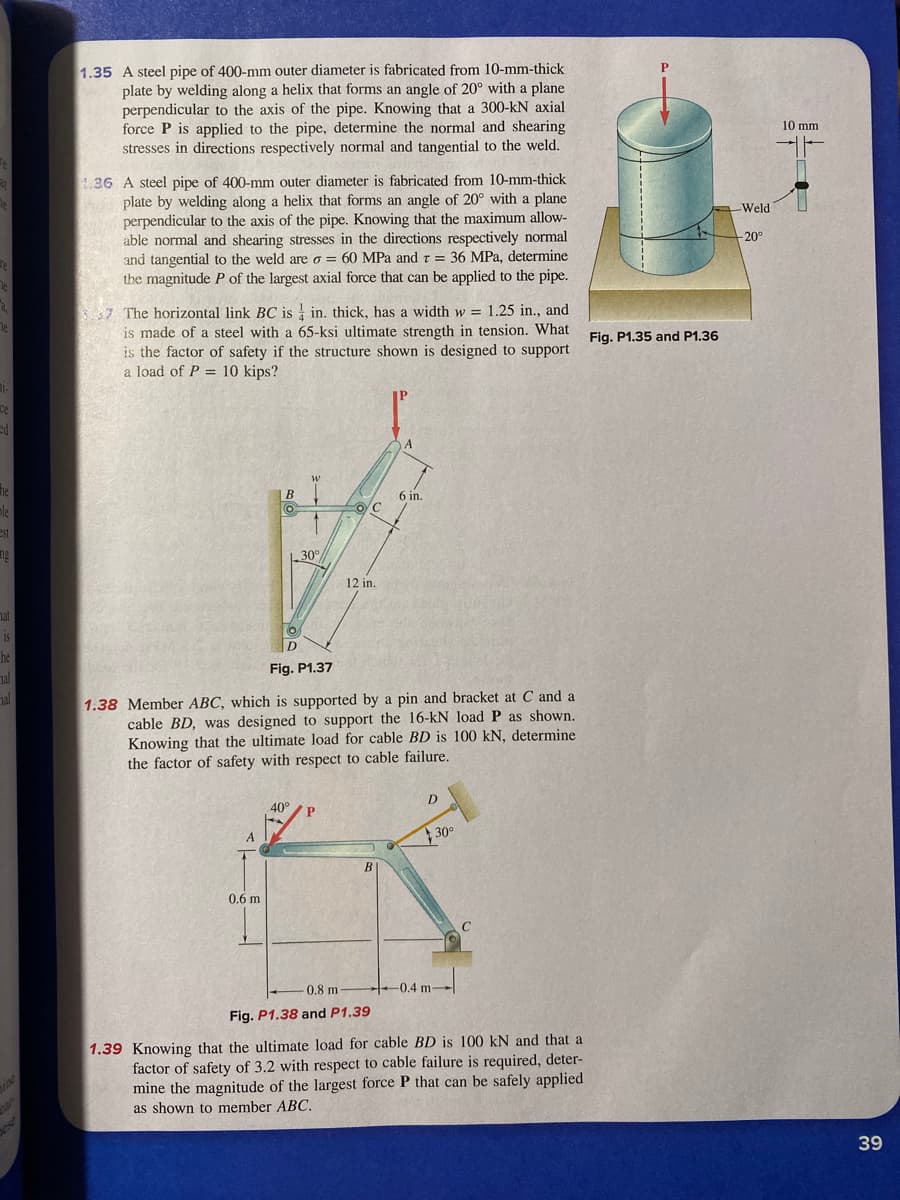1.35 A steel pipe of 400-mm outer diameter is fabricated from 10-mm-thick plate by welding along a helix that forms an angle of 20° with a plane perpendicular to the axis of the pipe. Knowing that a 300-kN axial force P is applied to the pipe, determine the normal and shearing stresses in directions respectively normal and tangential to the weld. 10 mm .36 A steel pipe of 400-mm outer diameter is fabricated from 10-mm-thick plate by welding along a helix that forms an angle of 20° with a plane perpendicular to the axis of the pipe. Knowing that the maximum allow- able normal and shearing stresses in the directions respectively normal and tangential to the weld are o = 60 MPa and r = the magnitude P of the largest axial force that can be applied to the pipe. Weld -20° 36 MPa, determine 37 The horizontal link BC is in. thick, has a width w = is made of a steel with a 65-ksi ultimate strength in tension. What is the factor of safety if the structure shown is designed to support a load of P = 10 kips? 1.25 in., and Fig. P1.35 and P1.36
1.35 A steel pipe of 400-mm outer diameter is fabricated from 10-mm-thick plate by welding along a helix that forms an angle of 20° with a plane perpendicular to the axis of the pipe. Knowing that a 300-kN axial force P is applied to the pipe, determine the normal and shearing stresses in directions respectively normal and tangential to the weld. 10 mm .36 A steel pipe of 400-mm outer diameter is fabricated from 10-mm-thick plate by welding along a helix that forms an angle of 20° with a plane perpendicular to the axis of the pipe. Knowing that the maximum allow- able normal and shearing stresses in the directions respectively normal and tangential to the weld are o = 60 MPa and r = the magnitude P of the largest axial force that can be applied to the pipe. Weld -20° 36 MPa, determine 37 The horizontal link BC is in. thick, has a width w = is made of a steel with a 65-ksi ultimate strength in tension. What is the factor of safety if the structure shown is designed to support a load of P = 10 kips? 1.25 in., and Fig. P1.35 and P1.36
Elements Of Electromagnetics
7th Edition
ISBN:9780190698614
Author:Sadiku, Matthew N. O.
Publisher:Sadiku, Matthew N. O.
ChapterMA: Math Assessment
Section: Chapter Questions
Problem 1.1MA
Related questions
Question
Only 1.35 plz

Transcribed Image Text:1.35 A steel pipe of 400-mm outer diameter is fabricated from 10-mm-thick
plate by welding along a helix that forms an angle of 20° with a plane
perpendicular to the axis of the pipe. Knowing that a 300-kN axial
force P is applied to the pipe, determine the normal and shearing
stresses in directions respectively normal and tangential to the weld.
10 mm
36 A steel pipe of 400-mm outer diameter is fabricated from 10-mm-thick
plate by welding along a helix that forms an angle of 20° with a plane
perpendicular to the axis of the pipe. Knowing that the maximum allow-
able normal and shearing stresses in the directions respectively normal
and tangential to the weld are o = 60 MPa and T = 36 MPa, determine
the magnitude P of the largest axial force that can be applied to the pipe.
-Weld
-20°
37 The horizontal link BC is in. thick, has a width w = 1.25 in., and
is made of a steel with a 65-ksi ultimate strength in tension. What
is the factor of safety if the structure shown is designed to support
a load of P = 10 kips?
Fig. P1.35 and P1.36
P
ce
he
6 in.
ole
est
ng
.30°
12 in.
nat
is
he
D
nal
Fig. P1.37
nal
1.38 Member ABC, which is supported by a pin and bracket at C and a
cable BD, was designed to support the 16-kN load P as shown.
Knowing that the ultimate load for cable BD is 100 kN, determine
the factor of safety with respect to cable failure.
D.
40°
30°
0.6 m
0.8 m
0.4 m
Fig. P1.38 and P1.39
1.39 Knowing that the ultimate load for cable BD is 100 kN and that a
factor of safety of 3.2 with respect to cable failure is required, deter-
mine the magnitude of the largest force P that can be safely applied
as shown to member ABC.
rine
39
Expert Solution
This question has been solved!
Explore an expertly crafted, step-by-step solution for a thorough understanding of key concepts.
This is a popular solution!
Trending now
This is a popular solution!
Step by step
Solved in 2 steps with 2 images

Knowledge Booster
Learn more about
Need a deep-dive on the concept behind this application? Look no further. Learn more about this topic, mechanical-engineering and related others by exploring similar questions and additional content below.Recommended textbooks for you

Elements Of Electromagnetics
Mechanical Engineering
ISBN:
9780190698614
Author:
Sadiku, Matthew N. O.
Publisher:
Oxford University Press

Mechanics of Materials (10th Edition)
Mechanical Engineering
ISBN:
9780134319650
Author:
Russell C. Hibbeler
Publisher:
PEARSON

Thermodynamics: An Engineering Approach
Mechanical Engineering
ISBN:
9781259822674
Author:
Yunus A. Cengel Dr., Michael A. Boles
Publisher:
McGraw-Hill Education

Elements Of Electromagnetics
Mechanical Engineering
ISBN:
9780190698614
Author:
Sadiku, Matthew N. O.
Publisher:
Oxford University Press

Mechanics of Materials (10th Edition)
Mechanical Engineering
ISBN:
9780134319650
Author:
Russell C. Hibbeler
Publisher:
PEARSON

Thermodynamics: An Engineering Approach
Mechanical Engineering
ISBN:
9781259822674
Author:
Yunus A. Cengel Dr., Michael A. Boles
Publisher:
McGraw-Hill Education

Control Systems Engineering
Mechanical Engineering
ISBN:
9781118170519
Author:
Norman S. Nise
Publisher:
WILEY

Mechanics of Materials (MindTap Course List)
Mechanical Engineering
ISBN:
9781337093347
Author:
Barry J. Goodno, James M. Gere
Publisher:
Cengage Learning

Engineering Mechanics: Statics
Mechanical Engineering
ISBN:
9781118807330
Author:
James L. Meriam, L. G. Kraige, J. N. Bolton
Publisher:
WILEY